David Vazquez
AgentAda: Skill-Adaptive Data Analytics for Tailored Insight Discovery
Apr 10, 2025Abstract:We introduce AgentAda, the first LLM-powered analytics agent that can learn and use new analytics skills to extract more specialized insights. Unlike existing methods that require users to manually decide which data analytics method to apply, AgentAda automatically identifies the skill needed from a library of analytical skills to perform the analysis. This also allows AgentAda to use skills that existing LLMs cannot perform out of the box. The library covers a range of methods, including clustering, predictive modeling, and NLP techniques like BERT, which allow AgentAda to handle complex analytics tasks based on what the user needs. AgentAda's dataset-to-insight extraction strategy consists of three key steps: (I) a question generator to generate queries relevant to the user's goal and persona, (II) a hybrid Retrieval-Augmented Generation (RAG)-based skill matcher to choose the best data analytics skill from the skill library, and (III) a code generator that produces executable code based on the retrieved skill's documentation to extract key patterns. We also introduce KaggleBench, a benchmark of curated notebooks across diverse domains, to evaluate AgentAda's performance. We conducted a human evaluation demonstrating that AgentAda provides more insightful analytics than existing tools, with 48.78% of evaluators preferring its analyses, compared to 27.67% for the unskilled agent. We also propose a novel LLM-as-a-judge approach that we show is aligned with human evaluation as a way to automate insight quality evaluation at larger scale.
StarFlow: Generating Structured Workflow Outputs From Sketch Images
Mar 27, 2025Abstract:Workflows are a fundamental component of automation in enterprise platforms, enabling the orchestration of tasks, data processing, and system integrations. Despite being widely used, building workflows can be complex, often requiring manual configuration through low-code platforms or visual programming tools. To simplify this process, we explore the use of generative foundation models, particularly vision-language models (VLMs), to automatically generate structured workflows from visual inputs. Translating hand-drawn sketches or computer-generated diagrams into executable workflows is challenging due to the ambiguity of free-form drawings, variations in diagram styles, and the difficulty of inferring execution logic from visual elements. To address this, we introduce StarFlow, a framework for generating structured workflow outputs from sketches using vision-language models. We curate a diverse dataset of workflow diagrams -- including synthetic, manually annotated, and real-world samples -- to enable robust training and evaluation. We finetune and benchmark multiple vision-language models, conducting a series of ablation studies to analyze the strengths and limitations of our approach. Our results show that finetuning significantly enhances structured workflow generation, outperforming large vision-language models on this task.
UI-Vision: A Desktop-centric GUI Benchmark for Visual Perception and Interaction
Mar 19, 2025Abstract:Autonomous agents that navigate Graphical User Interfaces (GUIs) to automate tasks like document editing and file management can greatly enhance computer workflows. While existing research focuses on online settings, desktop environments, critical for many professional and everyday tasks, remain underexplored due to data collection challenges and licensing issues. We introduce UI-Vision, the first comprehensive, license-permissive benchmark for offline, fine-grained evaluation of computer use agents in real-world desktop environments. Unlike online benchmarks, UI-Vision provides: (i) dense, high-quality annotations of human demonstrations, including bounding boxes, UI labels, and action trajectories (clicks, drags, and keyboard inputs) across 83 software applications, and (ii) three fine-to-coarse grained tasks-Element Grounding, Layout Grounding, and Action Prediction-with well-defined metrics to rigorously evaluate agents' performance in desktop environments. Our evaluation reveals critical limitations in state-of-the-art models like UI-TARS-72B, including issues with understanding professional software, spatial reasoning, and complex actions like drag-and-drop. These findings highlight the challenges in developing fully autonomous computer use agents. By releasing UI-Vision as open-source, we aim to advance the development of more capable agents for real-world desktop tasks.
AlignVLM: Bridging Vision and Language Latent Spaces for Multimodal Understanding
Feb 03, 2025



Abstract:Aligning visual features with language embeddings is a key challenge in vision-language models (VLMs). The performance of such models hinges on having a good connector that maps visual features generated by a vision encoder to a shared embedding space with the LLM while preserving semantic similarity. Existing connectors, such as multilayer perceptrons (MLPs), often produce out-of-distribution or noisy inputs, leading to misalignment between the modalities. In this work, we propose a novel vision-text alignment method, AlignVLM, that maps visual features to a weighted average of LLM text embeddings. Our approach leverages the linguistic priors encoded by the LLM to ensure that visual features are mapped to regions of the space that the LLM can effectively interpret. AlignVLM is particularly effective for document understanding tasks, where scanned document images must be accurately mapped to their textual content. Our extensive experiments show that AlignVLM achieves state-of-the-art performance compared to prior alignment methods. We provide further analysis demonstrating improved vision-text feature alignment and robustness to noise.
BigDocs: An Open and Permissively-Licensed Dataset for Training Multimodal Models on Document and Code Tasks
Dec 05, 2024



Abstract:Multimodal AI has the potential to significantly enhance document-understanding tasks, such as processing receipts, understanding workflows, extracting data from documents, and summarizing reports. Code generation tasks that require long-structured outputs can also be enhanced by multimodality. Despite this, their use in commercial applications is often limited due to limited access to training data and restrictive licensing, which hinders open access. To address these limitations, we introduce BigDocs-7.5M, a high-quality, open-access dataset comprising 7.5 million multimodal documents across 30 tasks. We use an efficient data curation process to ensure our data is high-quality and license-permissive. Our process emphasizes accountability, responsibility, and transparency through filtering rules, traceable metadata, and careful content analysis. Additionally, we introduce BigDocs-Bench, a benchmark suite with 10 novel tasks where we create datasets that reflect real-world use cases involving reasoning over Graphical User Interfaces (GUI) and code generation from images. Our experiments show that training with BigDocs-Bench improves average performance up to 25.8% over closed-source GPT-4o in document reasoning and structured output tasks such as Screenshot2HTML or Image2Latex generation. Finally, human evaluations showed a preference for outputs from models trained on BigDocs over GPT-4o. This suggests that BigDocs can help both academics and the open-source community utilize and improve AI tools to enhance multimodal capabilities and document reasoning. The project is hosted at https://bigdocs.github.io .
IntentGPT: Few-shot Intent Discovery with Large Language Models
Nov 16, 2024Abstract:In today's digitally driven world, dialogue systems play a pivotal role in enhancing user interactions, from customer service to virtual assistants. In these dialogues, it is important to identify user's goals automatically to resolve their needs promptly. This has necessitated the integration of models that perform Intent Detection. However, users' intents are diverse and dynamic, making it challenging to maintain a fixed set of predefined intents. As a result, a more practical approach is to develop a model capable of identifying new intents as they emerge. We address the challenge of Intent Discovery, an area that has drawn significant attention in recent research efforts. Existing methods need to train on a substantial amount of data for correctly identifying new intents, demanding significant human effort. To overcome this, we introduce IntentGPT, a novel training-free method that effectively prompts Large Language Models (LLMs) such as GPT-4 to discover new intents with minimal labeled data. IntentGPT comprises an \textit{In-Context Prompt Generator}, which generates informative prompts for In-Context Learning, an \textit{Intent Predictor} for classifying and discovering user intents from utterances, and a \textit{Semantic Few-Shot Sampler} that selects relevant few-shot examples and a set of known intents to be injected into the prompt. Our experiments show that IntentGPT outperforms previous methods that require extensive domain-specific data and fine-tuning, in popular benchmarks, including CLINC and BANKING, among others.
InsightBench: Evaluating Business Analytics Agents Through Multi-Step Insight Generation
Jul 08, 2024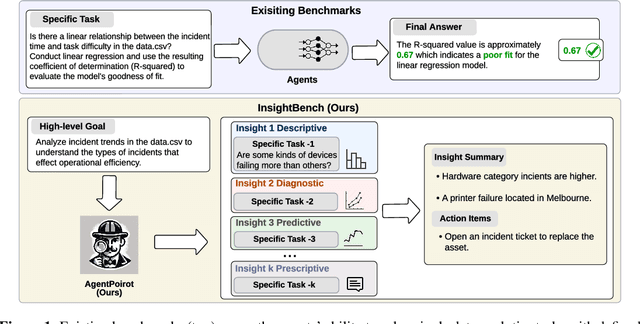
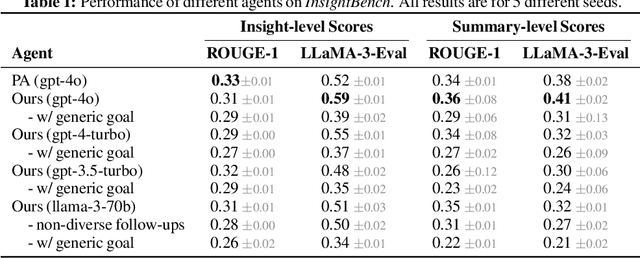

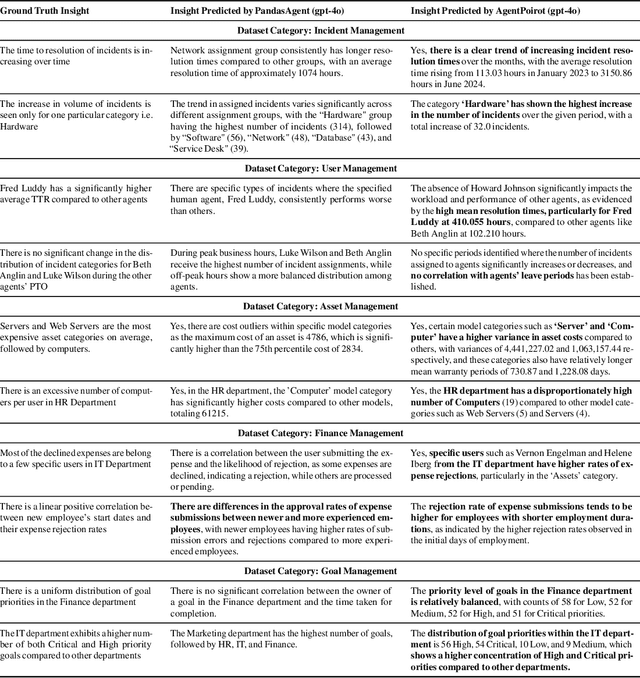
Abstract:Data analytics is essential for extracting valuable insights from data that can assist organizations in making effective decisions. We introduce InsightBench, a benchmark dataset with three key features. First, it consists of 31 datasets representing diverse business use cases such as finance and incident management, each accompanied by a carefully curated set of insights planted in the datasets. Second, unlike existing benchmarks focusing on answering single queries, InsightBench evaluates agents based on their ability to perform end-to-end data analytics, including formulating questions, interpreting answers, and generating a summary of insights and actionable steps. Third, we conducted comprehensive quality assurance to ensure that each dataset in the benchmark had clear goals and included relevant and meaningful questions and analysis. Furthermore, we implement a two-way evaluation mechanism using LLaMA-3-Eval as an effective, open-source evaluator method to assess agents' ability to extract insights. We also propose AgentPoirot, our baseline data analysis agent capable of performing end-to-end data analytics. Our evaluation on InsightBench shows that AgentPoirot outperforms existing approaches (such as Pandas Agent) that focus on resolving single queries. We also compare the performance of open- and closed-source LLMs and various evaluation strategies. Overall, this benchmark serves as a testbed to motivate further development in comprehensive data analytics and can be accessed here: https://github.com/ServiceNow/insight-bench.
RepLiQA: A Question-Answering Dataset for Benchmarking LLMs on Unseen Reference Content
Jun 17, 2024Abstract:Large Language Models (LLMs) are trained on vast amounts of data, most of which is automatically scraped from the internet. This data includes encyclopedic documents that harbor a vast amount of general knowledge (e.g., Wikipedia) but also potentially overlap with benchmark datasets used for evaluating LLMs. Consequently, evaluating models on test splits that might have leaked into the training set is prone to misleading conclusions. To foster sound evaluation of language models, we introduce a new test dataset named RepLiQA, suited for question-answering and topic retrieval tasks. RepLiQA is a collection of five splits of test sets, four of which have not been released to the internet or exposed to LLM APIs prior to this publication. Each sample in RepLiQA comprises (1) a reference document crafted by a human annotator and depicting an imaginary scenario (e.g., a news article) absent from the internet; (2) a question about the document's topic; (3) a ground-truth answer derived directly from the information in the document; and (4) the paragraph extracted from the reference document containing the answer. As such, accurate answers can only be generated if a model can find relevant content within the provided document. We run a large-scale benchmark comprising several state-of-the-art LLMs to uncover differences in performance across models of various types and sizes in a context-conditional language modeling setting. Released splits of RepLiQA can be found here: https://huggingface.co/datasets/ServiceNow/repliqa.
WorkArena: How Capable Are Web Agents at Solving Common Knowledge Work Tasks?
Mar 12, 2024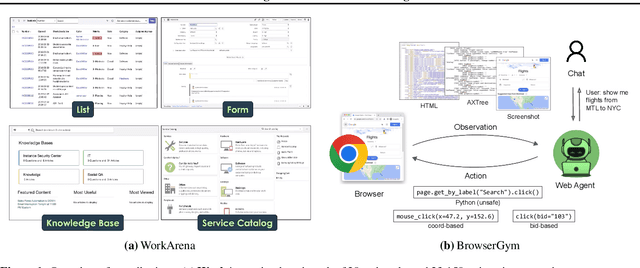
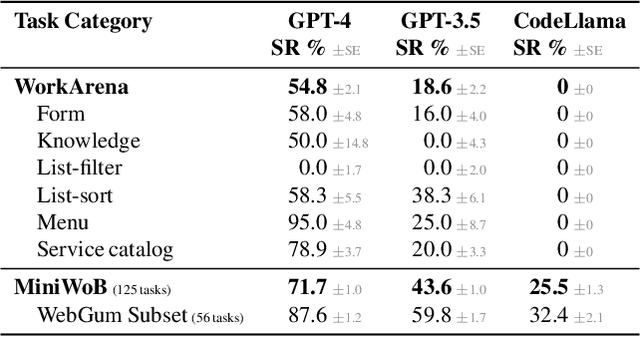
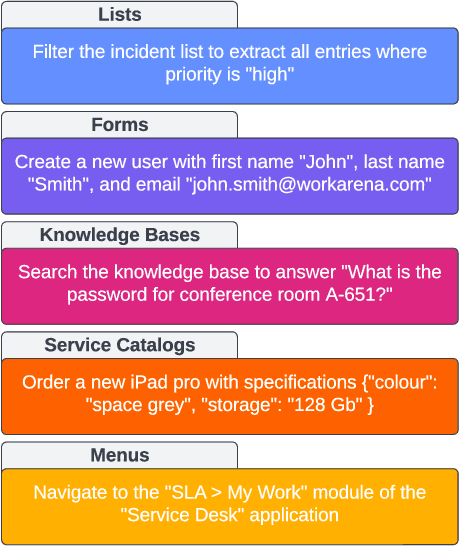
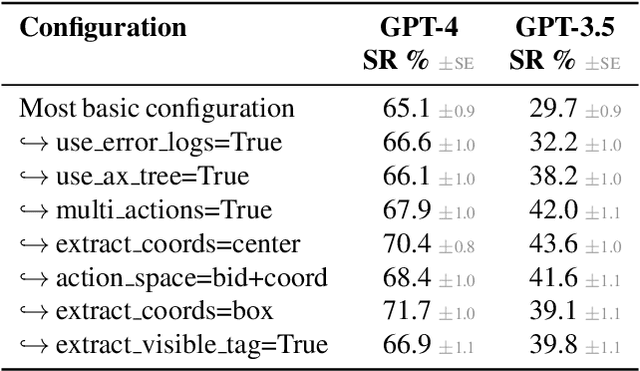
Abstract:We study the use of large language model-based agents for interacting with software via web browsers. Unlike prior work, we focus on measuring the agents' ability to perform tasks that span the typical daily work of knowledge workers utilizing enterprise software systems. To this end, we propose WorkArena, a remote-hosted benchmark of 29 tasks based on the widely-used ServiceNow platform. We also introduce BrowserGym, an environment for the design and evaluation of such agents, offering a rich set of actions as well as multimodal observations. Our empirical evaluation reveals that while current agents show promise on WorkArena, there remains a considerable gap towards achieving full task automation. Notably, our analysis uncovers a significant performance disparity between open and closed-source LLMs, highlighting a critical area for future exploration and development in the field.
Capture the Flag: Uncovering Data Insights with Large Language Models
Dec 21, 2023Abstract:The extraction of a small number of relevant insights from vast amounts of data is a crucial component of data-driven decision-making. However, accomplishing this task requires considerable technical skills, domain expertise, and human labor. This study explores the potential of using Large Language Models (LLMs) to automate the discovery of insights in data, leveraging recent advances in reasoning and code generation techniques. We propose a new evaluation methodology based on a "capture the flag" principle, measuring the ability of such models to recognize meaningful and pertinent information (flags) in a dataset. We further propose two proof-of-concept agents, with different inner workings, and compare their ability to capture such flags in a real-world sales dataset. While the work reported here is preliminary, our results are sufficiently interesting to mandate future exploration by the community.
 Add to Chrome
Add to Chrome Add to Firefox
Add to Firefox Add to Edge
Add to Edge